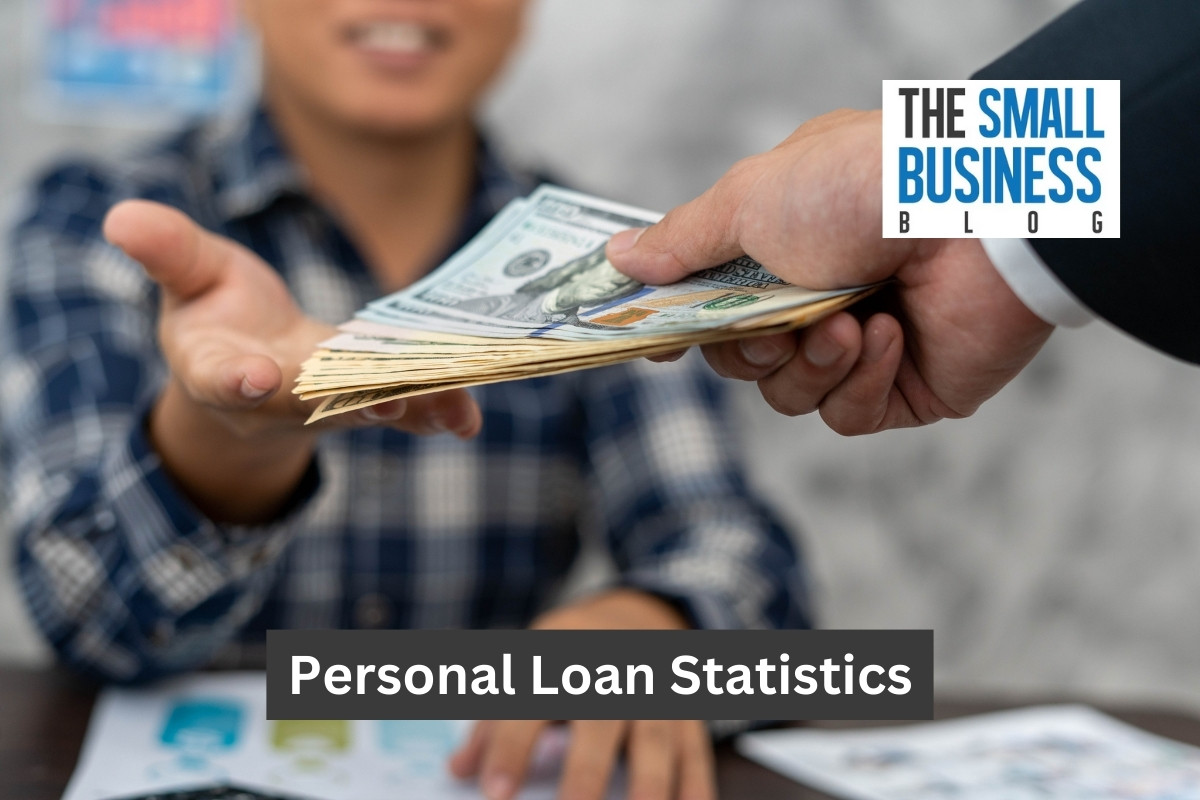Have you ever thought of borrowing money for your education expenses, dream vacation, or home renovation?
Personal loans can be used to fund those personal expenses.
This type of loan is beneficial to individuals depending on their financial needs.
When seeking a personal loan, borrowers must consider their capacity to pay their loan, interest rates, and fees at the right time.
Do you want to know more about personal loan statistics in 2024?
Let’s find out in this article.
Post Contents
- 1 Key Statistics
- 2 Top Personal Loan Statistics in 2024
- 2.1 1. On Average, the Personal Loan Interest Rate as of Q1 2023 Reached 11.48%
- 2.2 2. There Were 22.5 Million Personal Loan Borrowers in the US in Q4 2022, Up From Nearly 17 Million Five Years Ago
- 2.3 3. In Q4 2022, Over 22 Million American Borrowers Owed $222,000,000,000 in Personal Loan Debt.
- 2.4 4. The Fintech Companies Were the Largest Provider of Personal Loans in the United States in 2018, Granting About 38%
- 2.5 5. Baby Boomers Had the Most Amount of Average Personal Loan Balance in 2021, with $20,370
- 2.6 6. As of Q1 2023, a Credit Score of 720 Or More Has an Average APR of 14.34%
- 2.7 7. 61% of American Borrowers Take Out Personal Loans to Pay Off Other Debts
- 2.8 8. Hawaii Had the Highest New Personal Loan Account Balance in Q4 2022, with $13,258
- 2.9 9. About 4.14% of Personal Loan Accounts were Past Due for 60 Days Or More in Q4 2022
- 3 Conclusion
- 4 Sources
Key Statistics
- The average personal loan interest rate reached 11.48% in Q1 2023.
- Personal loan borrowers in the US exceeded 22 million in Q4 2022, up from less than 17 million five years ago.
- In 2022, American borrowers owe $222 billion in personal loan debt.
- The Fintech companies were the largest provider of personal loans in the US in 2018.
- Baby Boomers had the highest personal loan balance in 2021, with $20,370.
- As of Q1 2023, a credit score of 720 or more has an average interest rate of 14.34%.
- 61% of American borrowers use their personal loans to pay off other debts.
- About 4.14% of personal loan accounts were past due for 60 days or more in Q4 2022.
Top Personal Loan Statistics in 2024

1. On Average, the Personal Loan Interest Rate as of Q1 2023 Reached 11.48%
Before getting a personal loan, borrowers should review the terms and conditions, including the fees, payment schedule, and interest rate.
Reviewing these will help them know the monthly repayment obligation and the increasing total cost of borrowing.
They can assess whether the amount of loan fits their financial capabilities.
Interest rates affect the monthly loan payment and the overall cost since borrowers need to pay on top of the principal amount of the loan.
According to Forbes Advisor’s report, personal loan interest rates are between 4%-36%.
As of Q1 2023, the average personal loan interest rate reached 11.48%, up from 9.39% in the same quarter the previous year.
While in the last quarter of 2022, the average interest rate hit 11.21%.
(Forbes Advisor)
2. There Were 22.5 Million Personal Loan Borrowers in the US in Q4 2022, Up From Nearly 17 Million Five Years Ago
The number of personal loan borrowers in the United States surpasses 22.5 million in Q4 2022, up from 16.9 million five years ago.
From 2015 to 2019, the number of people with personal loans was from 14.4 million to 20.8 million.
The number dropped to 19.3 million after the previous height in Q4 2019 because of the COVID outbreak.
(Lending Tree)
3. In Q4 2022, Over 22 Million American Borrowers Owed $222,000,000,000 in Personal Loan Debt.
The unsecured personal loan balances of over 22 million American borrowers reached $222 billion in the fourth quarter of 2022.
It is up by 6% from the previous quarter and 33% last year.
This year’s personal loan debt is the highest in 17 years.
Here is the list of outstanding personal loan balances of Americans from 2018 to 2022:
- In 2018, American borrowers owed $136 billion in personal loan debt
- In 2019, American borrowers owed $157 billion in personal loan debt
- In 2020, American borrowers owed $145 billion in personal loan debt
- In 2021, American borrowers owed $167 billion in personal loan debt
- In 2022, American borrowers owed $222 billion in personal loan debt
(Lending Tree)
4. The Fintech Companies Were the Largest Provider of Personal Loans in the United States in 2018, Granting About 38%
In 2018, Fintech companies were the leading source that granted the most shares of personal loans in the United States, granting around 38% of personal loans.
Bank comes next, providing 28%, Credit Union, with 21%, and Finance companies, with 13%.
Compared to the shares in 2013, Fintech companies granted the lowest shares of personal loans in the country, with 5%.
While Banks provided the most, with 40%.
(Statista)
5. Baby Boomers Had the Most Amount of Average Personal Loan Balance in 2021, with $20,370
Borrowers born between 1946-1964, known as Baby Boomers, had the most amount of average personal loan balance in 2021, reaching $20,370, up by $19,700 the previous year.
On the other hand, Generation Z had the lowest personal loan balance, at $6,658.
Let’s take a look at the average personal loan balance by age group in 2021:
- Generation Z, aged 18 to 24, had a personal loan balance of around $6,658 in 2021
- Millennials, aged 25 to 40, had a personal loan balance of around $13,418 in 2021
- Generation X, aged 41 to 56, had a personal loan balance of around $18,922 in 2021
- Baby Boomers, aged 57 to 75, had a personal loan balance of around $20,370 in 2021
- Silent Generation, aged 76 and above, had a personal loan balance of around $17,334 in 2021
(Forbes Advisor)
6. As of Q1 2023, a Credit Score of 720 Or More Has an Average APR of 14.34%
A credit score represents the borrower’s creditworthiness.
A high credit score means that the borrower has a good track record.
While a low credit score indicates that the borrower had difficulties in the past.
People with high credit scores receive lower annual percentage rates (APR) or interest rates and higher average loan amounts.
As of Q1 2023, a credit score of 720 or more has an average APR of 14.34%.
Compared to a credit score of less than 560, the average APR is 165.30%.
People with at least a 720 credit score receive an average loan of $19,657.52, while those with less than 560 credit scores have an average loan of $2,568.42.
(Lending Tree)
7. 61% of American Borrowers Take Out Personal Loans to Pay Off Other Debts
Borrowers have different reasons why they get personal loans.
One of the most popular reasons is debt consolidation and credit card refinancing.
A survey shows that approximately 61% of American borrowers use their personal loans to pay off other debts.
Aside from that, 7.7% of borrowers in the country use their loans for home improvement, while 3.0% for medical bills.
About 2.3% use them for vacation, and 1.5% use them to cover wedding expenses.
(Chamber of Commerce)
8. Hawaii Had the Highest New Personal Loan Account Balance in Q4 2022, with $13,258
Average personal loan amounts vary per state in the US in Q4 2022.
Hawaii had the highest new personal loan account balance.
It had approximately $13,258. It was followed by New Hampshire, with $11,705, and New Jersey, with $11,338.
Colorado comes next, with $11,142, and Connecticut, with $10,981.
Meanwhile, the states in the US with the lowest personal loan account balance were Oklahoma, with $3,428, and Texas, with $3,914.
(Forbes Advisor)
9. About 4.14% of Personal Loan Accounts were Past Due for 60 Days Or More in Q4 2022

The percentage of people who are late in paying their scheduled loan payment or past due refers to delinquency rates.
When these borrowers fail to pay on time, or within a grace period, they are considered delinquent.
Accounts with 60 days or more past due can affect their credit score.
The latest report shows that about 4.14% of personal loan accounts were past due for 60 days or more in Q4 2022.
This rate increased from 3.00% in the previous year.
(Lending Tree)
Conclusion
A personal loan is a good option for individuals who need funds to cover medical, educational, or other expenses.
Based on the most recent data, personal loan borrowers in the US surpasses 22 million, from 14 million several years ago.
This means that personal loans grew in popularity.
Before borrowing, people should assess and evaluate their needs and budget first since personal loans are financial obligations.
That’s all about the latest personal loan statistics for 2024.
Thanks for reading.






























